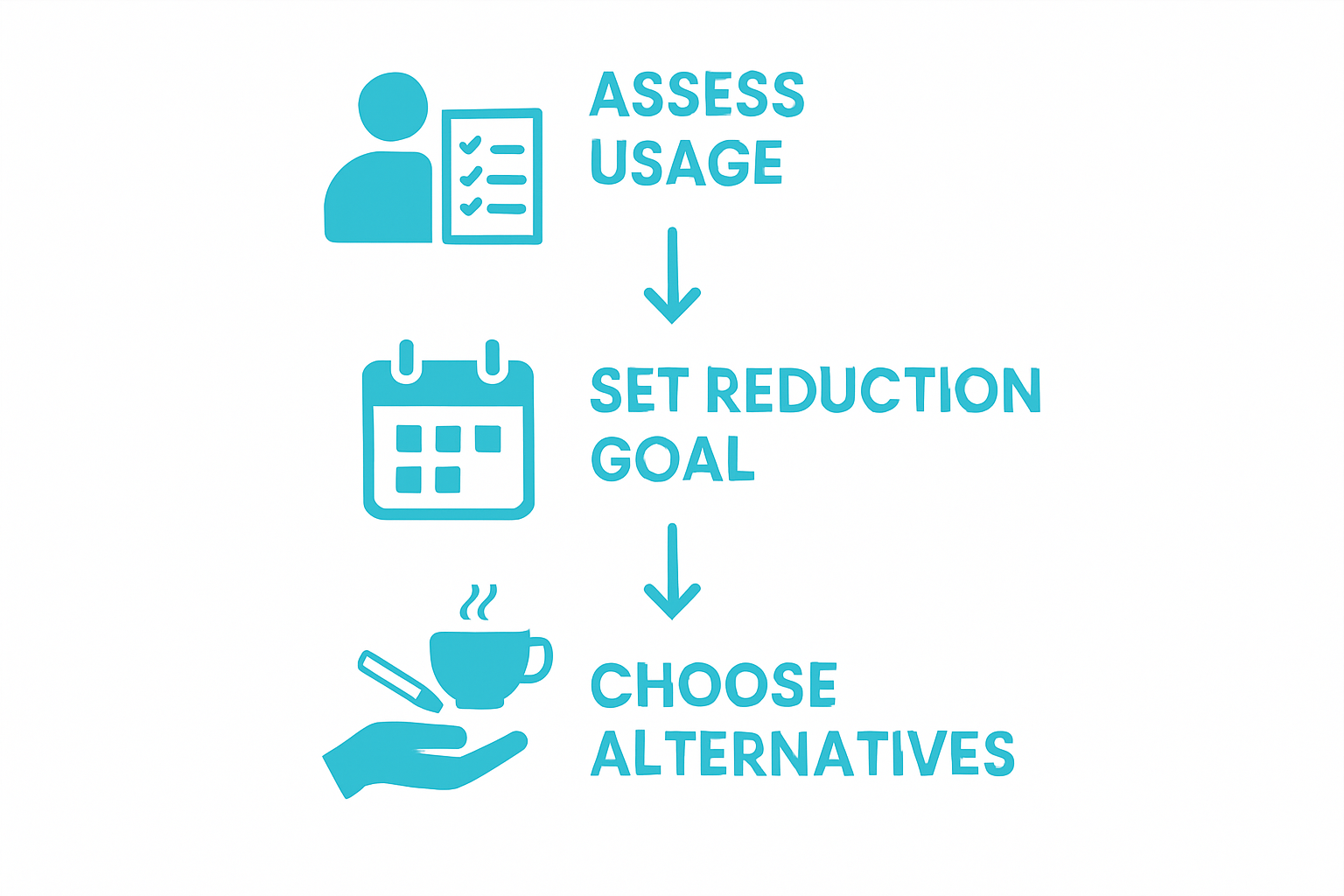

How to Reduce Nicotine Cravings Naturally for Wellness
Reducing nicotine cravings can feel overwhelming for anyone caught in the cycle of daily cigarettes or vape pens. Most people never realize the powerful impact of simply tracking when and why they reach for nicotine. Keeping a detailed log of your usage reveals hidden patterns and triggers that are easy to miss, and often these discoveries make all the difference in breaking free. It turns out your breakthrough might start with a pen and paper, not a patch or prescription.
Table of Contents
- Step 1: Assess Your Current Nicotine Usage
- Step 2: Identify Triggers And Craving Patterns
- Step 3: Develop A Personalized Action Plan
- Step 4: Incorporate Natural Remedies And Alternatives
- Step 5: Monitor Progress And Adjust Strategies
- Step 6: Practice Stress-Reduction Techniques
Quick Summary
| Key Point | Explanation |
|---|---|
| 1. Assess your nicotine usage thoroughly | Track daily nicotine intake and patterns to understand your dependency and establish a baseline for progress. |
| 2. Identify your triggers carefully | Document emotional, social, and environmental factors that provoke nicotine cravings to develop coping strategies. |
| 3. Create a personalized action plan | Set specific, realistic goals and strategies to manage cravings while incorporating supportive resources and techniques. |
| 4. Incorporate natural remedies and alternatives | Use herbal treatments and mindfulness practices to address cravings holistically and improve overall well-being. |
| 5. Monitor progress and adjust strategies | Keep a wellness journal to reflect on your journey, celebrate achievements, and adapt your approach based on experiences. |
Step 1: Assess Your Current Nicotine Usage
Understanding your current nicotine consumption is the foundational first step in successfully reducing nicotine cravings naturally. This assessment provides a clear picture of your smoking patterns, dependency level, and the specific challenges you’ll need to address. By carefully examining your nicotine usage, you create a personalized roadmap for wellness that acknowledges your unique relationship with nicotine.
To begin your assessment, track your daily nicotine intake meticulously. Record the number of cigarettes or nicotine products you consume each day, noting the times and contexts of your usage. Pay close attention to triggers that prompt your nicotine consumption - these might include stress, social situations, morning routines, or specific emotional states. Understanding these patterns reveals critical insights into your nicotine dependency.
The 7 Compelling Reasons Why Switch from Tobacco can provide additional motivation during this self-assessment process. Consider using a dedicated journal or smartphone app to document your nicotine consumption. Aim to capture not just quantity, but qualitative details like your emotional state, location, and what prompted each nicotine session.
According to research from the National Cancer Institute, a comprehensive assessment should include several key evaluation points:
- Total daily nicotine consumption
- Time interval between waking and first nicotine use
- Frequency of use in restricted environments
- Emotional and physiological responses when nicotine is unavailable
Be honest and thorough in your self-evaluation. Recognize that this is a judgment-free process designed to support your wellness journey. The goal is not to criticize your current habits but to create a clear, compassionate roadmap for reducing nicotine dependence. By gathering precise data about your nicotine usage, you’ll establish a baseline that allows you to track progress and celebrate incremental improvements in your health and lifestyle.
Step 2: Identify Triggers and Craving Patterns
Identifying your specific nicotine triggers represents a critical breakthrough in naturally reducing cravings. This step transforms your understanding from passive observation to active management, allowing you to predict and interrupt habitual nicotine consumption before it occurs. Triggers are unique personal experiences that spark an almost automatic urge to consume nicotine, ranging from emotional states to specific environmental cues.
Emotional and psychological triggers often represent the most challenging landscape to navigate. Stress, anxiety, boredom, happiness, and even social interactions can prompt nicotine cravings. Start by creating a detailed trigger journal where you document not just when you want to consume nicotine, but the precise emotional context surrounding that desire. Note the intensity of the craving, your emotional state, and any external circumstances that might have contributed to the trigger.
Physical environment and routine play significant roles in nicotine consumption patterns. 7 Compelling Reasons Why Switch from Tobacco highlights how deeply ingrained smoking behaviors can become. Pay attention to specific locations, times of day, social settings, or activities that consistently provoke nicotine cravings. These might include morning coffee, post-meal rituals, work breaks, social gatherings, or moments of solitude.
According to research from the National Cancer Institute, understanding trigger categories can help develop targeted intervention strategies:
- Emotional triggers connected to stress or mood
- Pattern triggers linked to daily routines
- Social triggers involving specific people or environments
- Withdrawal triggers related to physiological nicotine dependence
The goal is not to eliminate triggers entirely but to develop conscious awareness and alternative coping mechanisms. By meticulously tracking and understanding your unique trigger landscape, you transform unconscious habits into deliberate choices, creating a powerful foundation for reducing nicotine cravings naturally.
Step 3: Develop a Personalized Action Plan
Creating a personalized action plan transforms your nicotine reduction strategy from abstract intention to concrete implementation. This critical step bridges the gap between understanding your triggers and actually changing your behavior. Your action plan will serve as a dynamic roadmap, providing structure and accountability while remaining flexible enough to adapt to your unique journey.
Begin by establishing clear, realistic goals that break down your ultimate objective into manageable milestones. Instead of viewing nicotine reduction as an overwhelming challenge, segment your approach into incremental targets. For instance, consider reducing your daily nicotine consumption by a specific percentage each week or extending the time between nicotine usage gradually. This approach prevents overwhelming yourself and builds sustainable momentum.
7 Compelling Reasons Why Switch from Tobacco emphasizes the importance of having a comprehensive strategy. Your action plan should include specific contingency strategies for managing cravings, alternative stress management techniques, and supportive resources. Develop a toolkit of coping mechanisms such as deep breathing exercises, short walks, herbal teas, or mindfulness practices that can redirect your attention when nicotine cravings emerge.
According to research from Smokefree.gov, an effective action plan should incorporate several key components:
- Specific quit or reduction date
- List of personal motivations for reducing nicotine
- Detailed strategies for managing identified triggers
- Support network contact information
- Backup plans for challenging scenarios
Document your plan in a dedicated journal or digital tracking app, making it a living document that you can review and adjust. Regularly assess your progress, celebrating small victories and viewing any setbacks as opportunities for learning and refinement.
 Remember that developing a personalized action plan is not about achieving perfection, but about creating a compassionate, strategic approach to reducing nicotine cravings and improving your overall wellness.
Remember that developing a personalized action plan is not about achieving perfection, but about creating a compassionate, strategic approach to reducing nicotine cravings and improving your overall wellness.
Step 4: Incorporate Natural Remedies and Alternatives
Incorporating natural remedies and alternatives represents a holistic approach to reducing nicotine cravings that supports both physical and mental wellness. This step focuses on replacing harmful nicotine consumption with healthier, supportive alternatives that address the root causes of your cravings. By introducing natural interventions, you create a comprehensive strategy that nurtures your body and mind through the reduction process.
Herbal alternatives can play a transformative role in managing nicotine withdrawal. Consider exploring adaptogenic herbs like ashwagandha and holy basil, which help regulate stress responses and support nervous system balance. Herbal teas such as chamomile, peppermint, and passionflower can provide calming alternatives during moments of intense craving. These natural remedies not only distract from nicotine urges but also provide therapeutic benefits that support overall wellness.

7 Effective CBD Smoking Alternatives for Health & Wellness highlights the potential of plant-based alternatives in managing nicotine dependency. Mindfulness practices and breathing techniques represent another powerful set of natural tools. Deep breathing exercises, meditation, and progressive muscle relaxation can interrupt craving cycles by redirecting mental focus and reducing physiological stress responses.
According to research from the National Cancer Institute, incorporating mindfulness techniques can significantly impact nicotine craving management:
- Practice daily meditation for 10-15 minutes
- Use guided imagery during intense craving moments
- Engage in deep breathing exercises
- Develop a consistent mindfulness routine
Remember that natural remedies work best when integrated holistically. Experiment with different alternatives, observing how your body and mind respond. Keep a journal to track the effectiveness of various techniques, allowing you to refine your approach continuously.
Below is a table summarizing key natural remedies and alternatives discussed in the article, with their purpose and suggested methods of use.
| Remedy or Alternative | Purpose | Suggested Method of Use |
|---|---|---|
| Ashwagandha & Holy Basil | Stress reduction, nervous system support | Take as supplements or in herbal teas |
| Chamomile, Peppermint, Passionflower | Calm cravings, promote relaxation | Drink as herbal tea during cravings |
| CBD/Plant-Based Smokes | Tobacco and nicotine substitution | Use as a nicotine-free smoking ritual |
| Mindfulness Meditation | Manage cravings, lower stress | Practice 10-15 minutes daily |
| Deep Breathing Exercises | Interrupt cravings, reduce anxiety | Use during stressful moments/cravings |
| Yoga, Walking, Stretching | Relieve stress, redirect focus | Incorporate into daily routine |
| Wellness Journaling | Track effects, refine approach | Document techniques/results regularly |
Step 5: Monitor Progress and Adjust Strategies
Monitoring progress and adjusting strategies represents the most dynamic phase of reducing nicotine cravings naturally. This step transforms your reduction journey from a rigid plan into a responsive, adaptive process that honors your individual experiences and challenges. Successful nicotine reduction is not about perfection, but about consistent, compassionate self-assessment and strategic refinement.
Establish a comprehensive tracking system that goes beyond simply counting cigarettes or tracking nicotine consumption. Create a holistic wellness journal that captures not just quantitative data, but qualitative insights into your emotional landscape, stress levels, physical sensations, and psychological triggers. This multi-dimensional approach provides a nuanced understanding of your progress, revealing patterns and opportunities for strategic adjustment that simple numerical tracking might miss.
7 Compelling Reasons Why Switch from Tobacco emphasizes the importance of flexible, personalized approaches to nicotine reduction. Your tracking should include markers of overall wellness, such as improved sleep quality, reduced anxiety, increased energy levels, and enhanced respiratory function. These holistic indicators often provide more meaningful motivation than strict nicotine consumption metrics.
According to research from Smokefree.gov, an effective progress monitoring strategy should incorporate several key evaluation points:
- Weekly review of nicotine consumption patterns
- Assessment of emotional and physical wellness indicators
- Identification of successful and challenging coping mechanisms
- Celebration of incremental achievements
- Compassionate reflection on setbacks
Remember that adjusting strategies is not an admission of failure, but a testament to your commitment and self-awareness. Some weeks you might progress smoothly, while others might present more significant challenges. Approach each phase with curiosity and kindness, viewing your reduction journey as a dynamic, evolving process of personal growth and wellness. The most successful approach combines structured tracking with emotional intelligence and adaptable strategies.
Step 6: Practice Stress-Reduction Techniques
Stress reduction represents a critical cornerstone in naturally reducing nicotine cravings, addressing the fundamental emotional triggers that often drive nicotine consumption. Developing a robust toolkit of stress management techniques transforms your relationship with stress from a reactive pattern to a proactive, intentional practice. By understanding and implementing strategic stress-reduction methods, you create powerful alternatives to nicotine-based coping mechanisms.
Mindfulness meditation emerges as a particularly potent technique for interrupting stress cycles and managing nicotine cravings. Begin with short, accessible practices - even five minutes of focused breathing can significantly shift your physiological and psychological state. Practice breathing exercises that emphasize deep, diaphragmatic breathing, which helps activate your parasympathetic nervous system and counteract the fight-or-flight response typically triggered by nicotine withdrawal. Experiment with guided meditation apps, progressive muscle relaxation techniques, and body scan meditations to discover which approaches resonate most deeply with your personal stress management style.
Understanding the CBD Relaxation Guide: Nature’s Calm highlights the importance of holistic stress management strategies. Physical movement represents another powerful stress-reduction technique. Incorporate activities like yoga, walking, swimming, or gentle stretching that help release tension and redirect mental focus. These movements not only provide physical benefits but also create mindful interruptions in habitual stress response patterns that might typically trigger nicotine cravings.
According to research from the National Cancer Institute, effective stress-reduction strategies should include:
- Daily mindfulness practice
- Regular physical movement
- Intentional breathing techniques
- Emotional awareness and processing
- Consistent sleep and nutrition management
Remember that stress-reduction is a skill that develops with consistent practice. Be patient and compassionate with yourself, recognizing that each moment of intentional stress management is a powerful step toward breaking nicotine dependency. Your goal is not perfection, but progressive improvement in how you perceive and respond to stress, ultimately creating a more balanced, resilient approach to wellness.
Take the Next Step to Natural Nicotine-Free Wellness
You have learned how important it is to assess your habits, identify triggers, and use natural remedies to cut nicotine cravings for good. But when it comes to finding healthier, effective alternatives to tobacco or nicotine products, you might still struggle. Stress, routine, and cravings can make natural change tough, and you want a solution that fits your wellness goals while supporting mindful rituals and daily progress.
Discover Full Moons Club CBD Smokes and Herbal Cigarettes, crafted for people who want a clean, plant-based experience without the chemicals or addictive substances in tobacco. Our organic hemp smokes and herbal blends are thoughtfully made for those focused on natural stress reduction and mindful alternatives, so you can address cravings in a sustainable way.

Ready to replace triggers with support and transform your ritual? Visit Full Moons Club today and make your wellness journey easier. Shop now and take advantage of fast nationwide shipping so you can keep moving forward today—not someday. Your body and mind deserve this healthier upgrade.
Frequently Asked Questions
How can I assess my current nicotine usage?
To assess your current nicotine usage, track your daily intake by recording the number of cigarettes or nicotine products you consume each day, noting the times, contexts, and emotional triggers that prompt your usage. This will help you understand your patterns and dependency level.
What are some common triggers for nicotine cravings?
Common triggers for nicotine cravings can include emotional states like stress or anxiety, specific routines such as morning coffee, social interactions, or certain locations. Keeping a trigger journal can help you identify these patterns.
How do I create a personalized action plan to reduce nicotine cravings?
To create a personalized action plan, set clear, achievable goals for reducing nicotine consumption, establish strategies to manage cravings, and include coping mechanisms like deep breathing or mindfulness practices. Document your plan in a journal or app and adjust it as needed.
What natural remedies can help reduce nicotine cravings?
Natural remedies to help reduce nicotine cravings include herbal alternatives such as ashwagandha and chamomile, mindfulness practices like meditation and deep breathing, and physical activities such as yoga or walking. These can support both your mental and physical wellness during the reduction process.
Recommended
- 7 Compelling Reasons Why Switch from Tobacco – Full Moons Club
- Understanding the CBD Relaxation Guide: Nature’s Calm – Full Moons Club
- The Last Trick of Big Tobacco: What You Are Really Supporting When You – Full Moons Club
- 7 Effective CBD Smoking Alternatives for Health & Wellness – Full Moons Club

